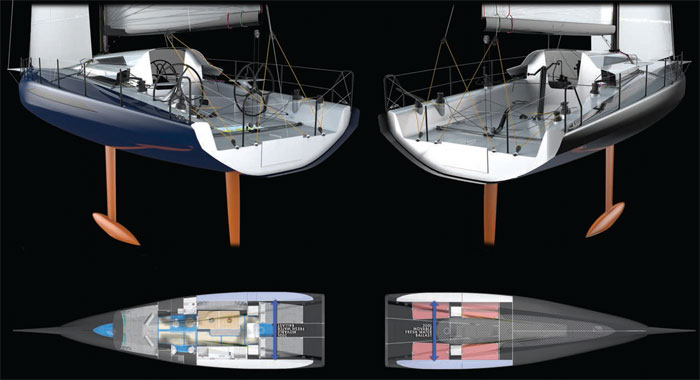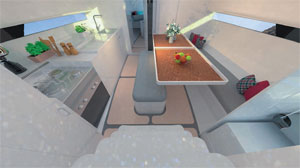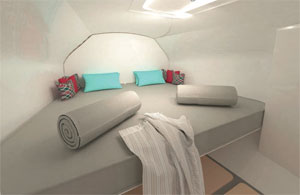

The stunning and stunningly affordable Aeolos P30 is about to get a big sister... Hans Genthe introduces us to his latest concept, the new P45
In various forums the question arises again and again: which cruising yachts can plane? In 1982 I had already dealt with this question for the first time and found a well-founded answer in the first edition of Konstruktion und Bau von Yachten by H. Dieter Scharping. I was then able to learn a lot more in the towing tank of the Hamburg Shipbuilding Research Institute during my shipbuilding studies – and to now see things more practically: The more curve in the underwater hull (rocker), the more difficult it is for the boat to detach itself from the wave system and leave its transom wave behind (planing). Roughly speaking, with any rocker angle of 15 degrees or less in the last 20-30 per cent of the craft, a boat can start surfing and eventually also plane.
The more weight a boat has, the more buoyancy it needs, and the more curved the lines underwater, the worse it can plane or surf. The planing ability therefore depends less on the beam and more on the weight. Wide-beam yachts can carry more weight with flatter lines. The BB10 can plane with only 2.3m of beam, but the boat weighs only 2.2t. But you have to mind the weight of your luggage – more than 30kg/person is not allowed!
Weight influences the shape: the lighter the boat, the flatter the underwater hull form. Then you just need to have enough sail area, and off you go. You can save weight by building lighter and/or leaving some comforts ashore.
The build improvements can include:- many large stringers that divide and stiffen the space inside (leaving little space for accommodation or stowage)
- high performance materials (expensive)
- install less stuff/comfort
- super light construction of any comforts you do have (very expensive)
A typical low-cost cruising yacht from a production shipyard has flat, shallow stringers, a thick (heavy) hull, cheap (heavy) equipment and is therefore overall heavy, round and not particularly buoyant. The opposite example is the ASSO 99 with zero degrees stern rocker angle and a displacement of just 1.1t at 10m length.

Since a keelboat cannot plane upwind, one could simply increase the sail area by using large downwind sails. But with heavy boats, this only helps in light winds.
So it becomes clear where to put the weight. Here are a few key figures about boats that I have sailed a lot and that can regularly plane.
All boats have an aft rocker angle of less than 10 degrees at the stern:- BB10: 10m, 2.2t, 1.2 ballast, planing starts at Force 5. Surfs at Force 4
- Farr 280: 8.7m, 1.35t, 0.65t ballast, planing: Force 3-4
- ASSO 99: 10m, 1.1t , starts planing at Force 3
- Rainbow 42: 12.7m, 3,6t, 1,6t ballast, planing: Force 4-5
- Rogers 46: 14m, 6t, 3t ballast, planing: Force 4
- Dehler 35 SQ: 10.5m, 5.5t, ballast 1,8t, does not plane, can surf
- Hallberg Rassy 41: 12m, 12t, lots of ballast, never planes
- Swan 48: 14.6m, 16.7t, never planes, but is nice upwind
During my work for Elvstrøm I sailed a lot of cruising yachts. I always went out with the new sails to check them... but I never had a planing experience in the three years I was doing it.

Creating a new touring experience
Encouraged by the success of the Aeolos P30 I’ve made a concept for a light 45ft yacht with a lot of comfort (in my opinion). I don’t want to follow marketing-driven design or rating trends with this boat. Sure, the rating parameters are a bit optimised, but not at the cost of hull performance. The P45 is designed for shorthanded sailing with a crew of two, and for long distance sailing or racing with a target average wind range of 12-25 kts. But the boat can also be sailed with a crew of 6-8. The hull is CFD optimised by FluidEngineeringSolutions in Germany and for the structural engineering Solico, in the Netherlands, was chosen again. VMax is the partner for the ORC optimisation.
The Aeolos P45 Luxus racing version is the lightest compromise in terms of comfort that I can imagine. All parts are made of carbon prepreg with foam core. If you look at the key data of this boat, it quickly becomes clear that not much extra equipment can be taken along! On the other hand, most parts of the equipment become cheaper, e.g. the engine. As a thumb value one can say 2.5 kW/knot is enough to reach hull speed.

The interior design of the Aeolos P45-L is rather conservative. Small improvements on a classic yacht layout that works well on the sea and in harbour. With its style and grace, the Aeolos P45-L has an interior arrangement offering abundant space and volume for a crew of six. The three-cabin layout comprises an owner’s cabin forward with a spacious heads, and two cabins to starboard and port, both aft. For racing you can add six floating bunks.
My vision is to offer a yacht that is fun to sail in a regatta like the Caribbean 600, a yacht that has the potential to win when racing with friends, and one that offers the pleasure of a nice sailing holiday with the family after the race series. But if you don’t want to compromise, then choose the pure race version. The AP45-R is the perfect fusion of technology and design. Tiller, grinder, inside almost nothing but a lot of fun during offshore racing.
Hull
Outside, the Aeolos P45 breaks with the mainstream. Her crisp, streamlined lines are designed to cut through the waves and eat the miles. The profile and proportions are unmistakably based on the Aeolos P30. Athletic with clear contours and powerful curves.

In light winds this design has low wetted area and a very slender waterline. The circular forward sections offer maximum volume with small surface area when sailing upright.
This boat moves through the waves quite smoothly when heeled – the bow section always presents the same shape between 0-30 degrees of heel.
But the most powerful design aspect here is the flat stern section even when heeling. The near to zero exit angle of the stern lines when heeled, means the perfect planing shape. And at up to 30-degrees heel the keel weight works very effectively allowing you to fly your gennaker or code zero for longer than usual.
Form follows function
With the low, rounded sheerline and aerodynamic coachroof, but especially due to the hull shape in front of the mast, the Aeolos P45 presents considerably lower wind resistance than other yachts of similar size. In school I learned early: wind resistance increases as the square of speed! The sheerline can produce huge turbulence and drag, the wider the boat, the more this tends to be.

The P45 has a very high aspect fractional rig with the mast step aft and an enormous gennaker
Specifications
Aeolos P45
- luxury, reliable, light.
- single/double-handed (OSR2)
- inshore racing with six
- CE-Norm Category B (offshore)
- upgrade to A with additional equipment possible
- length: 13.6m (length overall: 15.94m)
- beam: 3.9m
- 4.05t empty but rigged boat without sails
- weight of keel bulb & fin: 2t
- ballast ratio: more than 50 per cent (2,000kg)
- draught: 2.9m
- draught with optional retractable keel: 2.9m - 1.6m
- mast height above waterline: 22.42m
Sail area (depends on the setup, ORC, IRC or One Design)
- jib 63 sqm (ORC)
- main 78 sqm (ORC)
- upwind 141 sqm (ORC)
- 272 sqm gennaker (ORC)
Rig
- tapered carbon mast
- carbon boom
- carbon bowsprit, foldable (in harbour) and removable (for transport)
- Halyard blocks: Gennaker (top), Code 0 (1:2, top), Main (1:2), Jib 1, Jib 2, Cutter stay
P: 19.44 m
E: 5.55 m
I: 17.93 m
J: 6.29m
I spin: 20.94 m
TPS: 9.08 m
Especially when heeling, our air flow onto the jib has less turbulence so on the Aeolos P45, the jib is much more effective due to employing more usable area. The coachroof has low wind resistance and keeps the water out of the cockpit. If you have to work on the bow in windy conditions you will love this angled deck, it offers an almost horizontal gangway when the boat heels.
To save weight, we went the route of using carbon prepregs extensively, postcured epoxy construction and Alexseal 501 finish instead of gelcoat. At the same time, we designed the structure as part of the interior and did not add an inner shell. The unique carbon keel structure – a keel box and keel made of unidirectional carbon fibre – provides improved stiffness and resistance at reduced weight. All structural hull parts are laminated into the hull, meaning the hull is truly one solid piece.
The new Notus NE7 prepreg system was developed by our sister company Notus Composites, also based in the UAE. The novel lowtemperature curing chemistry offers significant cost advantages and has allowed us to switch from the infusion lamination process without developing expensive new hightemperature tooling. The overall production cost is similar to or even lower than using vacuum infusion due to cost savings in the shop during application and cleaning... less waste and lower health and safety costs.
Keel
With a huge ballast ratio of 50 per cent, this boat gives you a new experience of speed. The T-keel consists of a full carbon fin with lead bulb for high strength and low centre of gravity. The keel build is totally encapsulated in unidirectional and multiaxial carbon with epoxy for maximum safety in case of grounding. The keel is securely bolted to the structural carbon keel box with stainless steel bolts. A retractable carbon T-Keel offering a draught range from 1.6-2.9m is an option.
Rudder System
The generously proportioned twin steering wheels offer plenty of security to control this beast in any situation. You can choose between double 'hump-back’ rudders (for long offshore races in average windspeed of 20kts, and very fast downwind) or a single rudder (which is ideal for an average windspeed of 12kts and is very fast upwind).
Click here for more information on Aeolos Composites »
We invite you to read on and find out for yourself why Seahorse is the most highly-rated source in the world for anyone who is serious about their racing.
To read on simply SIGN up NOW
Take advantage of our very best subscription offer or order a single copy of this issue of Seahorse.
Online at:
www.seahorse.co.uk/shop and use the code TECH20
Or for iPad simply download the Seahorse App at the iTunes store


